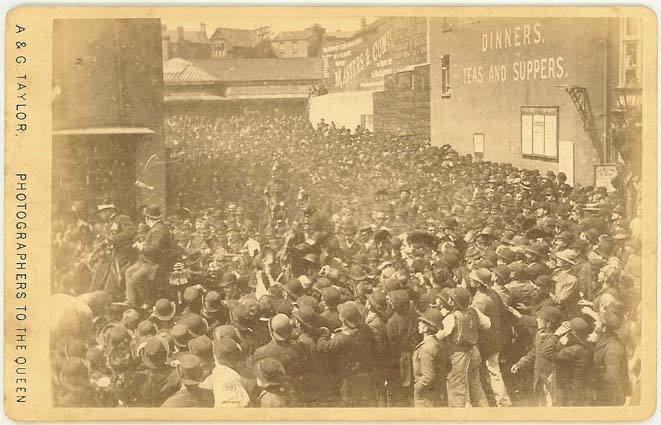The gentleman in the picture is the ‘grand old man of Liberalism’, William Ewart Gladstone. He is pictured here in his carriage at the station approach in June 1887. He appears to be well protected by members of the Newport Police Force, who were under the charge of its long-serving Chief Constable, Alan Inderwick Sinclair. I presume that Gladstone is being escorted to a meeting at the Albert Hall on Stow Hill where he was to address a large audience drawn from all over Monmouthshire. This rather drab building opened in 1875, and was a very popular venue for conferences, concerts and lectures because it could accommodate 1,100 people and had several suites of apartments and offices. Some time after this picture was taken the Miners’ Federation of Great Britain held their national conference there, possibly because of Stow Hill’s radical, Chartist connections.
In June1887 Gladstone had not long fallen from power. His Liberal administration, having made an alliance with Irish Nationalists to defeat Lord Salisbury's government the previous year, introduced a Home Rule Bill for Ireland; the Liberal Party then split and a break-away group went on to create the Liberal Unionist Party. The bill, which was thrown out on its second reading, effectively ended Gladstone’s third ministry. After only a few months Lord Salisbury returned to office.
In 1886 Newport had also thrown out its Liberal M.P., Mr E. H. Carbutt, and had elected a Conservative, Sir George Elliot. Nevertheless, Liberalism still had mass grass-root support throughout South Wales in the 1880s and 1890s, and Liberal Associations dominated the social and political life of towns such as Newport. Such levels of support are evident from the vast number of people in this photograph. Indeed, between 1886 and 1892 the Liberal Party was strengthened in Wales by seven by-election victories; more people in the Principality were in favour of Home Rule for Ireland than were opposed to it, and only a minority of Welsh Protestants supported the resistance of Irish Protestants to self-government for Ireland. Gladstone, the High Churchman, therefore, tended to be popular in nonconformist South Wales. He was also the only British politician who had disestablished a Church, in Ireland in 1869, and, by 1887, the disestablishment of the Church of Wales had become part of official Liberal policy.
A&G Taylor was a very important late-Victorian firm of artists and photographers. Founded in London in the 1860s by Andrew and George Taylor, by the late1880s it had expanded enormously, with branches in most parts of the country. The company established offices in Swansea and Cardiff, and later opened a studio at Wesley Chambers, 157 Commercial Street Newport. Portraits at this branch office cost between 3s 6d to 10s 6d per dozen prints. It is not clear from trade directories when A&G Taylor established their offices in Newport, but it would seem that it was after 1887 when Wesley Chambers were re-fitted.
